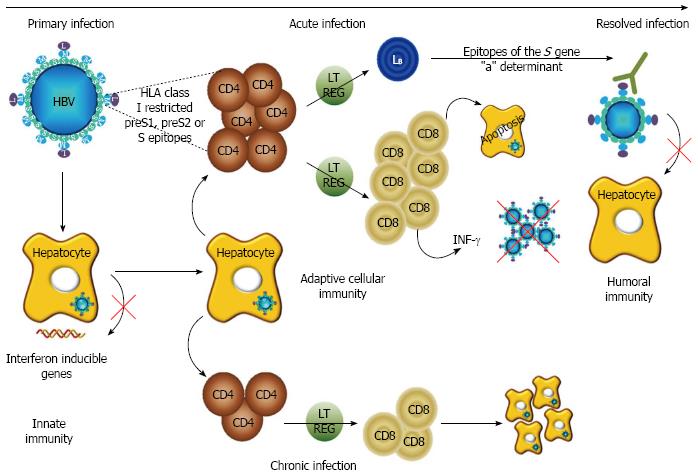Copyright
©2013 Baishideng Publishing Group Co.
World J Gastroenterol. Feb 7, 2013; 19(5): 654-664
Published online Feb 7, 2013. doi: 10.3748/wjg.v19.i5.654
Published online Feb 7, 2013. doi: 10.3748/wjg.v19.i5.654
Figure 2 Role of the hepatitis B surface protein in the immune response to hepatitis B infection.
Hepatitis B virus (HBV) primary infection does not induce activation of intracellular antiviral mechanisms through transcription of interferon inducible genes. After acute infection, the evolution to resolved hepatitis B is promoted by a vigorous and multispecific T cell response (CD4+ and CD8+ T cell) through hepatocyte apoptosis and interferon (IFN)-γ secretion, while evolution to chronicity is characterized by a weak and focused T cell response. Regulatory T cells (Treg) cells (LT REG) limit the function of effector T cells preventing excessive auto-destructive disease. A protective immunity is due in part to humoral and cellular anti-envelope response, preventing HBV attachment to hepatocytes, thus playing a critical role in prevention of infection after classical vaccination and in viral clearance in resolved hepatitis. HLA: Human leukocyte antigen.
- Citation: Jeulin H, Velay A, Murray J, Schvoerer E. Clinical impact of hepatitis B and C virus envelope glycoproteins. World J Gastroenterol 2013; 19(5): 654-664
- URL: https://www.wjgnet.com/1007-9327/full/v19/i5/654.htm
- DOI: https://dx.doi.org/10.3748/wjg.v19.i5.654









